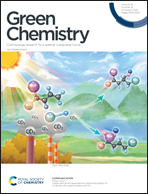Conversion of plastic waste into high-value lubricants: techno-economic analysis and life cycle assessment†
Abstract
Given the low recycling rate of plastic waste in the United States due to low economic incentives, it is of great interest to develop a technology to upgrade plastic waste with favorable economics. Plastic upcycling to valuable chemicals could ensure a circular economy for plastics and reduce the environmental burden caused by their end use cycle and disposal. A conceptual facility to convert 250 metric ton (MT) per day of plastic waste was modeled; the main product was a high-quality liquid (HQL) with a similar performance to polyalphaolefin (PAO) lubricants. The modeled process had a lubricant yield of up to 90% based on the experimental results at the laboratory scale. Techno-economic analysis (TEA) and life cycle assessment (LCA) were also performed to evaluate the process economics and its environmental impact. By using a mixture of colored and natural high-density polyethylene (HDPE), the production cost was in the range of $0.6–$1.98 per kg of lubricant, depending on the operating conditions. The life cycle emissions were in the range of 0.48–1.2 kgCO2e kgLub−1 showing, for the best case scenario, a 52% reduction relative to the emissions for petroleum lubricants, and a 74% reduction relative to the emissions for PAO lubricants. The impacts of the lubricant yield, the catalyst amount, and reaction time were evaluated, and their effect on the final production cost was discussed.

- This article is part of the themed collection: Measuring Green Chemistry: Methods, Models, and Metrics


 Please wait while we load your content...
Please wait while we load your content...